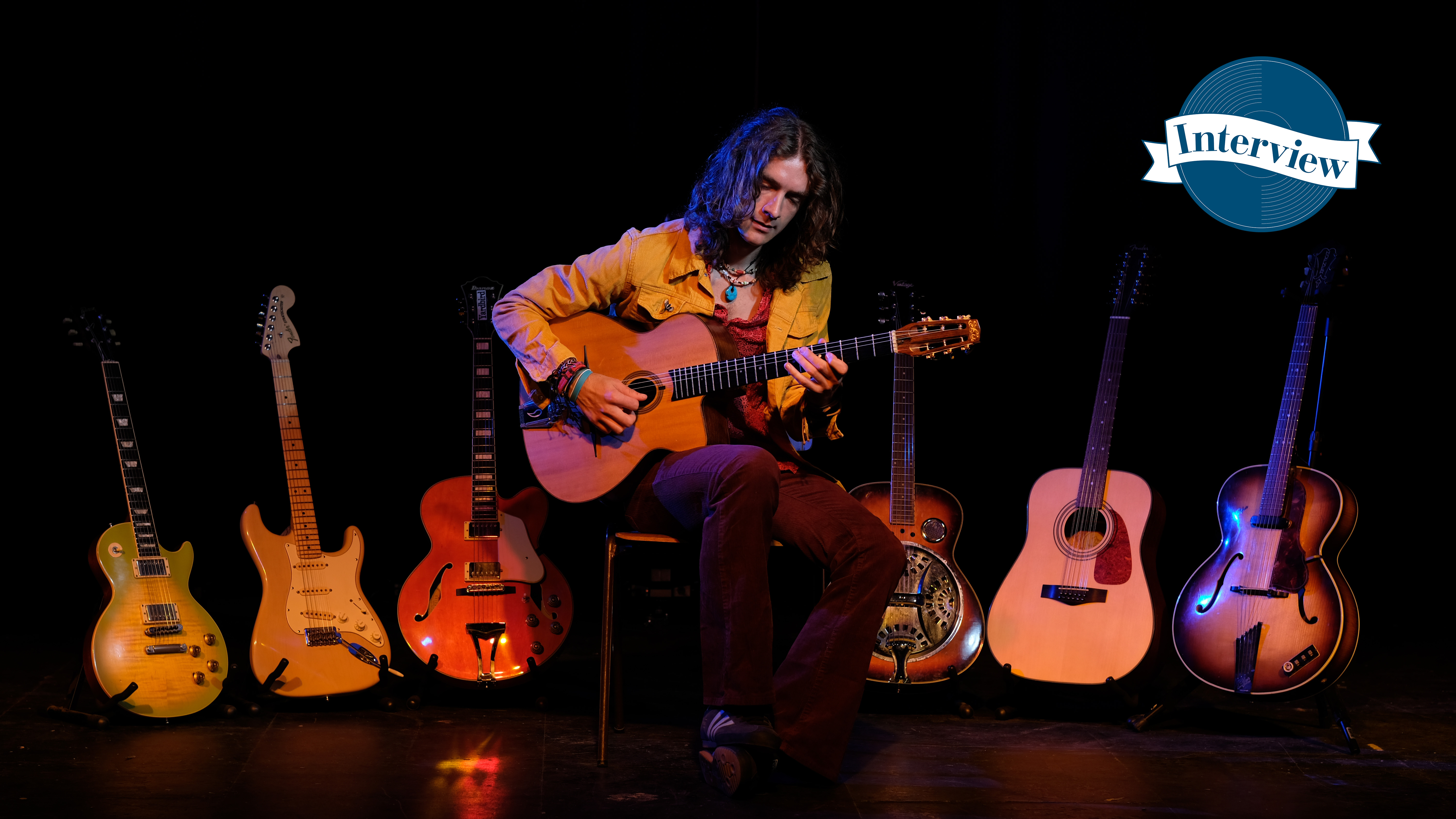
If you are a guitar player and you haven't done so already, you need to check out Remi Harris. But just as you've got to grips with him being one of the UK's foremost gypsy jazz guitarists, he'll go and throw you a brilliant curveball. Remi is a sublime blues-rock player too – so good he's been out wowing audiences with his own Peter Green tribute tour, Man Of The World.
Many will know that playing Peter Green's music and doing it justice is serious business; it requires the nuance of touch and tone that will really single out the gifted. Remi has been preparing for it since childhood when his dad first introduced him to Green's music and the instrument that would become his passion and living.
So this is an interview bridging those two worlds; gypsy jazz and the blues with a player who thrives in both.
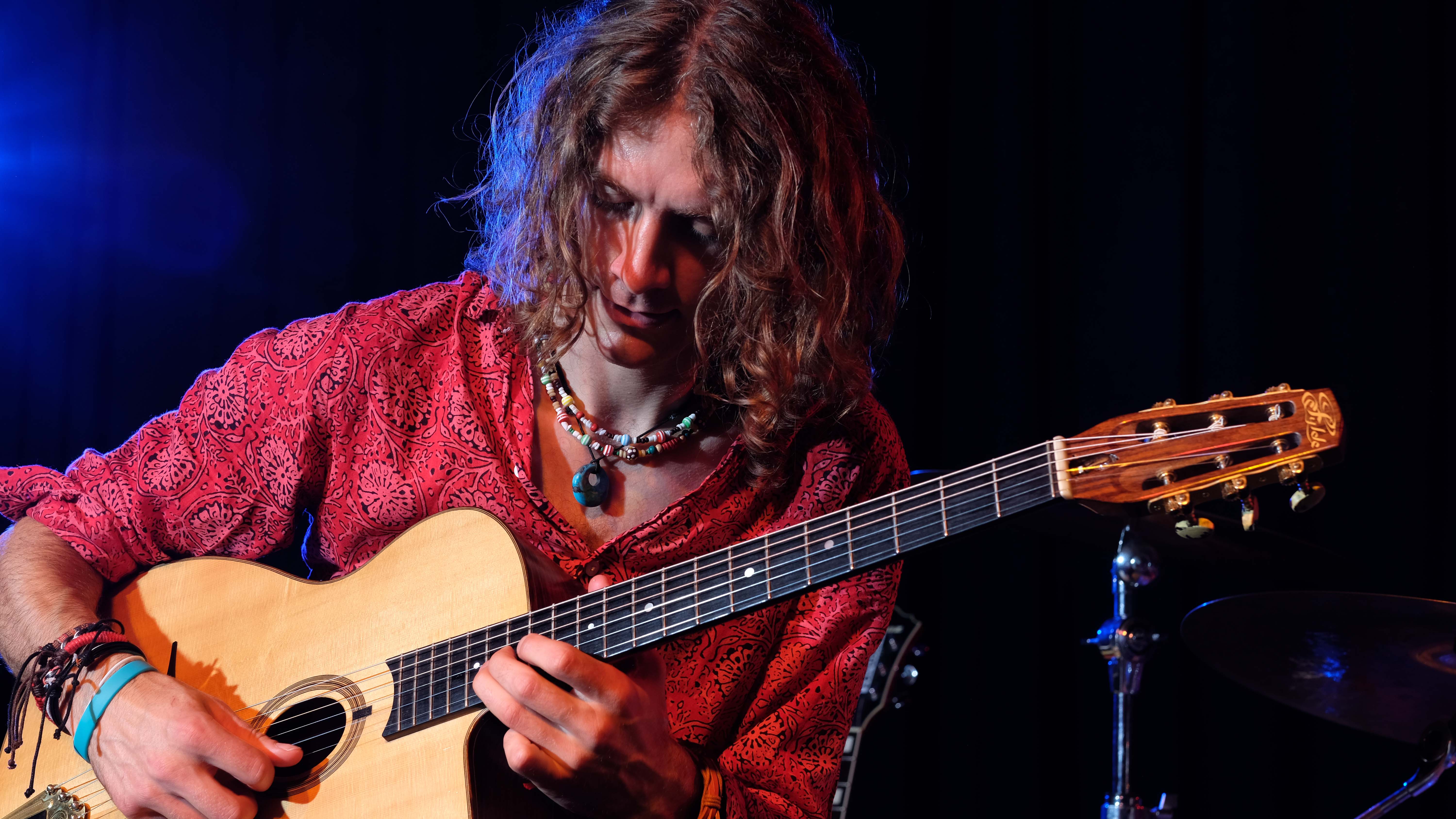
It was recently the 70th anniversary of Django Reinhardt's death – what does his music and legacy mean to you?
"First and foremost, a massive inspiration – as a player and the material that he wrote. And also he kind of kickstarted this whole genre of gypsy jazz, which didn't really exist before him. So he started a whole complete genre, not just a style of guitar playing, but also a kind of culture now with the gypsy jazz scene. His music has had a huge impact on my life since I was around 20 years old. That is when I really got into that kind of music."
Django started a whole complete genre, not just a style of guitar playing
Are you self-taught?
"My dad played guitar and so he taught me a few chords and stuff at the beginning. And then I kind of mostly learned from guitar magazines when I was a kid, because he taught me how to read tab. And I'd just flick through his guitar magazines and learn stuff I liked, but I've had a bit of help along the way as well. And obviously having dad there was a big help as well."
Get the MusicRadar Newsletter
Want all the hottest music and gear news, reviews, deals, features and more, direct to your inbox? Sign up here.
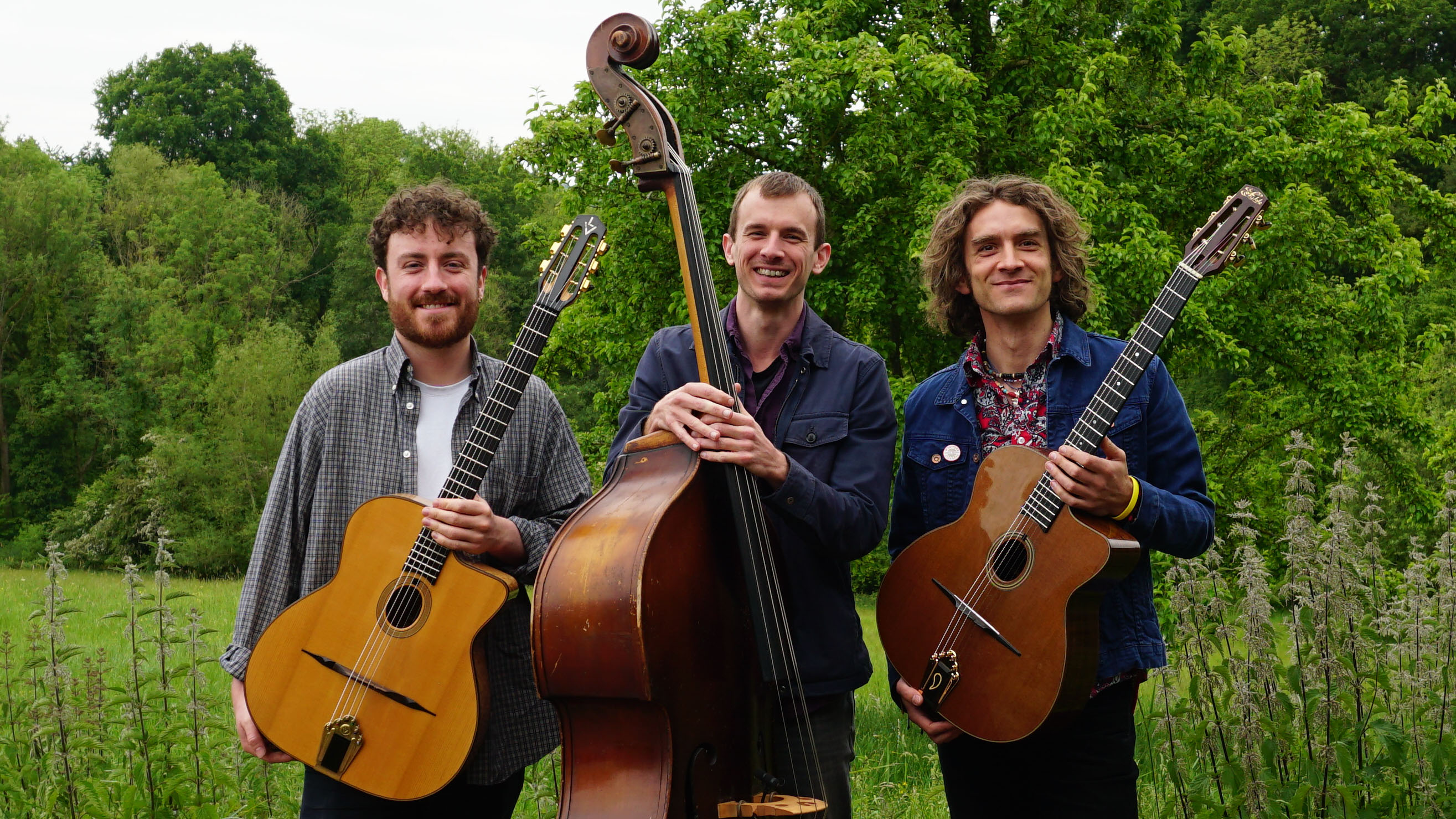
What was it like for you, as a young guy getting into gypsy jazz – was there a community in the UK for it when you started?
"There is more so now I think, but I had a few mates back then when I first started getting into it, and we used to jam. It was a good chance to get together, and play all night sometimes just jamming on tunes. And then I started going to the Samois-sur-Seine festival in France, the Django Reinhardt festival. And that opened up a whole world to me, because I'd be getting involved in jam sessions with people from all over the world.
"I'd come back every year with a list of things that I want to kind of work on – songs that I need to learn and all this kind of thing. And there are a few festivals over here, as well, that we used to go to and play and hang out and jam. It's quite social music, so it's good to be involved with that."
I know everybody wants to get straight into the flashy lead stuff but you've got to start with the chords because you need to be able to play rhythm parts well
It's a great gateway to jazz for a rock player because of its energy and melody. But where should a guitar player start with learning gypsy jazz?
"I would say first start with learning chords. I know everybody wants to get straight into the flashy lead stuff but you've got to start with the chords because you need to be able to play rhythm parts well. And you've got to know the standards – the chord sequences, because all the lead stuff makes no sense if there's no standard sequence that it goes over the top of. That's like the foundations of the music.
"So learn some chord shapes, learn how to play some swing rhythm, and learn some chord sequences – the whole sequences to jazz standards. And then get jamming as soon as possible. Start playing with people. And then gradually start to learn some lines, maybe learn a few short solos, licks, phrases, that kind of thing. That's when you start putting your kind of improvising vocabulary together."
A post shared by Remi Harris (@remi_harris)
A photo posted by on
And when players do get to the stage of learning licks they should get your book – 100 Gypsy Jazz Licks!
"Obviously that book is packed full of phrases that you can use. And we call them licks, but really, for me, they're short studies that give you an example of how you might play over a chord change, like a 251, or something like that. And learning vocabulary in this way is how you kind of develop your own vocabulary, because you'll naturally pick ideas you like from different phrases, and that will become part of your improvising fingerprint, if you will."
The majority of what I learned from was videos and audio
Was YouTube any help when you were learning this style or was it still taking off in terms of video tuition?
"There wasn't a lot, I don't think there was as much tutorial stuff on YouTube but there were videos of jam sessions, which were useful. There was footage of gigs too – just camcorders at the back of gypsy jazz festivals and stuff like that. So I used to go on and kind of look at the players and, and transcribed bits I liked.
"The majority of what I learned from was videos and audio. So I'd just transcribe things I liked from records and videos that I saw as well. And the videos were useful, because you could figure out the fingerings that they were using, which obviously you don't get off a recording."
Why do you think gypsy jazz attracts listeners and guitar players who might not be interested, initially at least, in other forms of jazz?
"I think gypsy jazz is quite accessible. To a non-jazz fan it's good, fun music. It's got a really good energy – the kind of thing you can have on at a party. Gypsy jazz bands get booked for weddings and celebrations because it's upbeat, and you don't really need to understand jazz in the same way you might with other styles where you have to be really familiar with it. Gypsy jazz immediately grabs you."
Some people have put forward the idea that Django was sweep-picking before the technique even got that name. What's your take on that?
"Yes, the rest stroke picking that he did. I guess it is kind of sweeping. I don't know if he was the first but he probably is the first that I can think of on recordings. But I'm not sure how far back the technique goes."
There's also this whole other side to your playing with blues rock. Does that go back to your roots?
"Yes, that was from like the beginning. It was my dad's record collection, basically. The Beatles and Neil Young were kind of my first musical loves. And then pretty soon after that, it was Jimi Hendrix and Led Zeppelin and Peter Green, Free with Paul Kossoff, Deep Purple and all those kind of things. I grew up playing that with bands and with friends through my teens. And now I'm playing that stuff again, after a bit of time off it when I was first getting into gypsy jazz."
I've become more and more in love with Peter Green's playing
And this has led to your Man Of The World Peter Green tribute gigs. You've done one tour with that so far, is the plan to do more?
"So the plan with that project is to do two tours a year, every spring and autumn."
Is Peter Green's music something you especially gravitated to early on?
"Yes, I would say he's in the top two or three players. I remember hearing him when I was maybe 10, or 11, something like that. I still have a vivid memory of first listening to Love That Burns – one of the recordings from a CD my dad had – and just being completely captivated by it. And so he has always been a huge influence on me. I think as time has gone on actually that's grown. I've become more and more in love with his playing."
What do you feel is special about his playing?
"It's hard to sum it up, really, but I think if you're analysing his playing from a purely technical point of view, I think he had a great sense of time – his swing was so good. I listened to the way he phrases timing, over the beats, and that's such a unique thing to his playing. And of course, his subtlety. He's obviously well-known for playing with subtlety.
"But he also had the kind of ability to really burn and play with a lot of intensity as well. Especially if you listen to some of the bootlegs from the John Mayall days – that Clapton-esque, Beano record way of playing. So he could do all that. And then of course, on top of this amazing guitar playing with the tone and the touch, we've also got the songs that he wrote, which are some of my favourite songs ever written. Man Of The World and Green Manalishi – all this kind of stuff. So yes, he had so much going for him."
I'm also aware with those gigs, as opposed to when I do my own blues rock gigs, where I'll be playing my own original stuff and other things, is that there's a room full of people, myself included, who are massive Peter Green fans
How do you balance authenticity with improvisation when you're playing Peter Green's music in front of his fans?
"So that's a funny one because when I do the Peter Green gigs, I don't play his solos note for note. There are a few other ones, like the Man Of The World solo, where it's basically the same every time because it's almost known part of the composition. But for his solos where he would have been improvising, I'm improvising as well, but trying to play within his kind of spirit, if you will.
"But I'm also aware with those gigs, as opposed to when I do my own blues rock gigs, where I'll be playing my own original stuff and other things, is that there's a room full of people, myself included, who are massive Peter Green fans. We're there to celebrate him. And so there are certain elements of my own playing that I will kind of hold back – parts where I might otherwise experiment a bit more with bringing some jazz influences in. I'll be careful about putting that in because it's not right for the occasion – because we're here to celebrate Peter Green. So although I play naturally, it's not like I'm character acting, I'm trying to be respectful of the situation. So that's the difference between those gigs maybe some of my other blues rock gigs."
What's the lineup for the Peter Green shows?
"My mate Dave Small is the vocalist, plays harmonica and he also does percussion as well. And Tom Moore on bass, he also plays double bass when we do the jazz stuff. On drums we had Shane Dixon, who's a mate of mine from school and we grew up playing together. He's actually unavailable for this next tour so we've got a couple of other friends playing drums– Nicky and Sam, who will come into play drums for that tour."
Peter Green had a very specific pickup setup with his Greeny Les Paul. Can you talk us through how you approach that?
"The previous two guitars I was using was my Les Paul standard, which is like a gecko colour. We call it the Gecko because they call it a Gecko Burst, which is a really unusual colour. And that's been my main Les Paul since I was a teenager, and it has been modded with out-of-phase wiring. But basically, virtually all of my guitars have had that mod – I even had it done on my Strats because I use that tone so much in everything that I do.
"So that's the guitar I used for that [first] tour. And we also had a Lemon Drop, which is by the Vintage brand [the V100]. It belongs to a friend and that was the second guitar that I swapped back to occasionally. But for this next tour, I've actually got one of the new Greeny models that have just been released."
The Gibson Les Paul Standard Greeny?
"Yes and it actually belongs to a friend too. But he's kind of lent it to me on a kind of long-term loan. And he's like, 'Go and play it, I want you to use it. So I'll be having that for the next tour. And I'll probably have the Gecko with me as my spare."
There are some misconceptions about the out-of-phase pickup in the original Greeny, because it's both the wiring and the install, right?
"So apparently, as far as I understand it, the actual magnet inside the pickup is backwards as well. So not only is the pickup fitted backward into the guitar, but also the magnet is physically out.
"It's a big mystery why, actually. But I've heard stories that it was taken apart and it was put back together wrong or something like that. And it's funny because apparently, and I don't know much about this, but if you just flip the pickup around it doesn't become out of phase, you still have to wire it out phase as well.
"So Peter Green's guitar was physically out of phase, upside down and wired out of phase. Whereas my Gecko is just wired out of phase. So there is a slight tonal difference and every guitar that I have that's out of phase, the tone really differs depending on how the pickups interact."
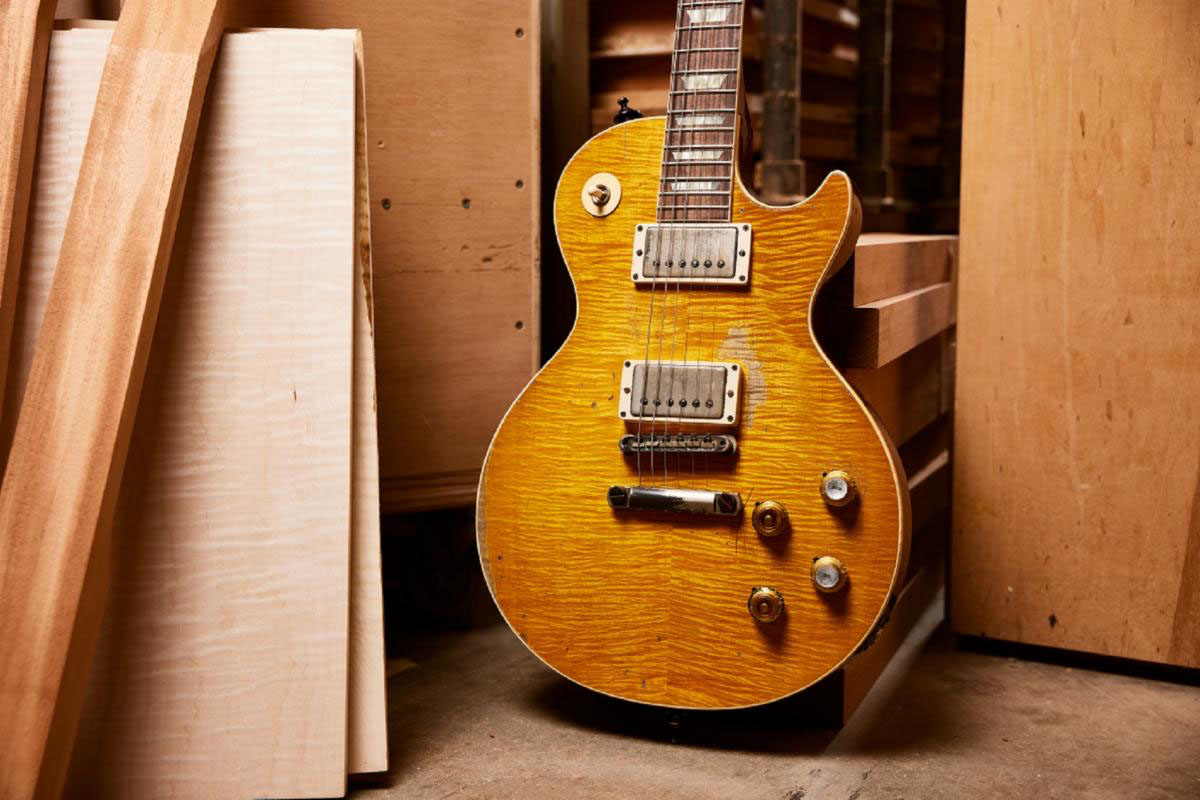
I think for some people the out-of-phase tone can be a kind of shrill, but for me it sounds delicate"
What are your impressions of the full Greeny signature experience after trying the Gibson model?
"I love it. It's such a cool guitar to play. Aside from the Peter Green Link, it's just a really amazing Les Paul – it's great. It's got a chunkier neck than my Gecko, because it's more kind of '50s [profile] and I think my Gecko has a '60s style neck. So it's got a different feel to it, and the frets feel a little lower and a little narrower. But you get used to that. But the tone of it is really something special. I really love it."
How would you describe the out-of-phase tonality?
"It's kind of like a nasally sound that you lose a lot of bass. And I think for some people that can be kind of shrill, almost, but for me it sounds delicate. And it's got this real nice honk in the midrange. And the great thing about when you do it on two pick-up guitars like a Les Paul, versus my Strat which is slightly different, the volume pots interact with each other. Because the level of one of the pickups affects the extremity of the out-of-phase effect.
"So when the volumes are both set to the same level, like all the way up, for example, the out-of-phase is at its most extreme, because the phase cancellation is at its most extreme. Then, roll down one of the pots, the out-of-phase sound will cut – I don't know if phase cancellation is the right term, but the out-of-phase effect becomes less. So you've got so much tonal variety by blending the two pickups and adjusting. I'm always tweaking the knobs just to find a sweet spot for the particular moment you're in."
And you're controlling gain from the volume pots most of the time?
"Most of the time, yes. Sometimes I have a clean boost if I need to go from a cleaner sound up to a more overdriven sound. But basically, most of it is done on the pots."
What's your amp and pedal setup?
"So on that tour that I've just done, I actually bought a Fender '68 Custom Deluxe Reverb, one of the new ones. I actually didn't have a guitar amp before that, and about a week before the tour we bought this Deluxe. And it sounds really great but the one thing with it is it's so loud. And to get the sound, that kind of driven blues-rock sound, you have to have it loud… and you just can't. And so, despite it only being like 22 watts or something, in most venues it's too loud to get that tone. And so I compensated depending on which venue I was in. Because you've got to be versatile, you can't just be like, 'This is my sound – like it or lump it', because then you make enemies with sound engineers.
"So I was using the Line 6 Helix for my reverbs and inside that I actually pulled up a King Of Tone-style overdrive model – like an overdrive pedal. I was using that to compensate. So if I needed the amp quieter, I could add gain on the overdrive. Then if I could have the amp louder, I could pull the gain back on the overdrive so I could still find that sweet spot.
"Since then, I've got a different amp. I've still got the Deluxe but a mate of mine bought a Victory V40, and he's actually given it to me to use – it's actually the same, mate who owns the Greeny Les Paul. So that's going on the next tour. I'm going to probably use that amp, then perhaps I might run [it with the Deluxe] side by side at times.
It's all about the sound for me, and the way it feels, and digital stuff, I think does a great job. Analogue stuff does a great job too, there's no reason to hang your hat on just one
"With the Victory amp, you can get the gain at lower volumes because you've got a master volume and you can push the preamp a bit. I haven't figured out what I'm going to do about the reverbs yet, because using the full Helix just for reverbs is a bit of overkill, really. So I'll probably get some kind of smaller reverb pedal."
You're not a purist when it comes to analogue vs digital then?
"It's all about the sound for me, and the way it feels, and digital stuff, I think does a great job. Analogue stuff does a great job too, there's no reason to hang your hat on just one. And actually, the reverbs in the Line 6 stuff, the room reverb in particular, I really love them. The Helix is a big board, but I was actually running through it with just the reverbs and then a bit of overdrive at times. But I'm looking at the HX Stomp or perhaps the TC Electronic Hall Of Fame.
"With the Peter Green gig, I need three separate reverbs. I have one room reverb that's on all the time – a small room reverb, sounding like the second [Fleetwood Mac] album, The Mr Wonderful album. Which is that kind of blues small club sound, almost.
"Then there are certain points in the songs there's much more cavernous reverb needed – for certain parts of solos, or for the Albatross bit where the slide comes in. So for that I step on an extra reverb and I have two plate-style reverbs. I either use one on its own or stack the two to get even bigger."
Tracks like Oh Well must be really satisfying to play in the Peter Green set, but what deeper cuts do you enjoy?
"Well, my favourite tunes to play are Love That Burns and Stop Messin' Around. Obviously, they're both blues, but Love That Burns is very slow and Stop Messin' Around is a shuffle-type thing. And I just love playing those because, as as a guitarist, I just feel like I have so much freedom to get in the zone and improvise."
Your last album was On Track in 2002, and that was jazz. Will your next album be blues rock?
"Yes, that's the plan. I've done three jazz albums so far and I think it's time to start putting down some of the other stuff that I that I've kind of been working on. Some of the stuff goes back to my childhood that I've got to kind of finish and rehearse up with a band and get it recorded."
Is it true that with your gypsy jazz records, you record the rhythm parts after you've tracked the solos?
"Yes, I did for my last two albums. The first album was actually recorded with a trio in a live kind of setting. But the last two albums were done in a layered fashion. So I record the lead first against kind of a click track. Which is sometimes just a metronome on two and four – a simple click – but sometimes I might have a shaker in there to give a swing feel. Then I'll record the lead to that, and just kind of picture the chords.
"Then I play the rhythm to the leads so as I'm playing rhythm, I kind of bounce off the lead player in the same way a drummer would. I always love that when you listen to Zeppelin live, Bonham is behind Page, and then Page will do something and Bonham will come in, in response to it. So I want that, I want that in my rhythm playing [responding] to my lead playing, if that makes sense."
If you record the rhythm and then play lead on top, it's more kind of karaoke
The rhythm role in gypsy jazz is almost a lead part in itself with the dynamics.
"Yes, to me it is. The other way around, if you record the rhythm and then play lead on top, it's more kind of karaoke. But if you want the rhythm to be part of the lead and to be accompanying it, then you have to hear the lead.
"It's also like a big band arrangement as well. I love big band music, and you'll have the melody played by whatever instrument is on the top. But then the harmonies of the underlying horns, and rhythm section will accent what's happening within the melody. So I kind of think of it like that as well."
I think that before I learned jazz, I couldn't play through changes
Starting in blues before playing gypsy jazz, and then kind of refocusing again on blues rock, are there any ways you can identify that understanding elements of jazz has benefited your blues approach?
"Massive, huge – it's completely transformed my blues playing. I think learning jazz – gypsy jazz, obviously, is kind of a subgenre of jazz. But just jazz in general, I think that before I learned jazz, I couldn't play through changes – chord changes. And now I think pretty much exclusively in chord changes when I'm playing. And that's through learning jazz. And I believe that I think that way, when I play blues as well, I'm thinking chord changes.
"Before, when I was a teenager, I might be playing in a pentatonic shape, and just using my ear and just playing around. Whereas now I have a much better understanding of the music underneath. And that's really informed by my lead playing. So I recommend getting a little bit into jazz, even if it's not for gigging – just kind of just understanding it a little bit. Because it really helps."
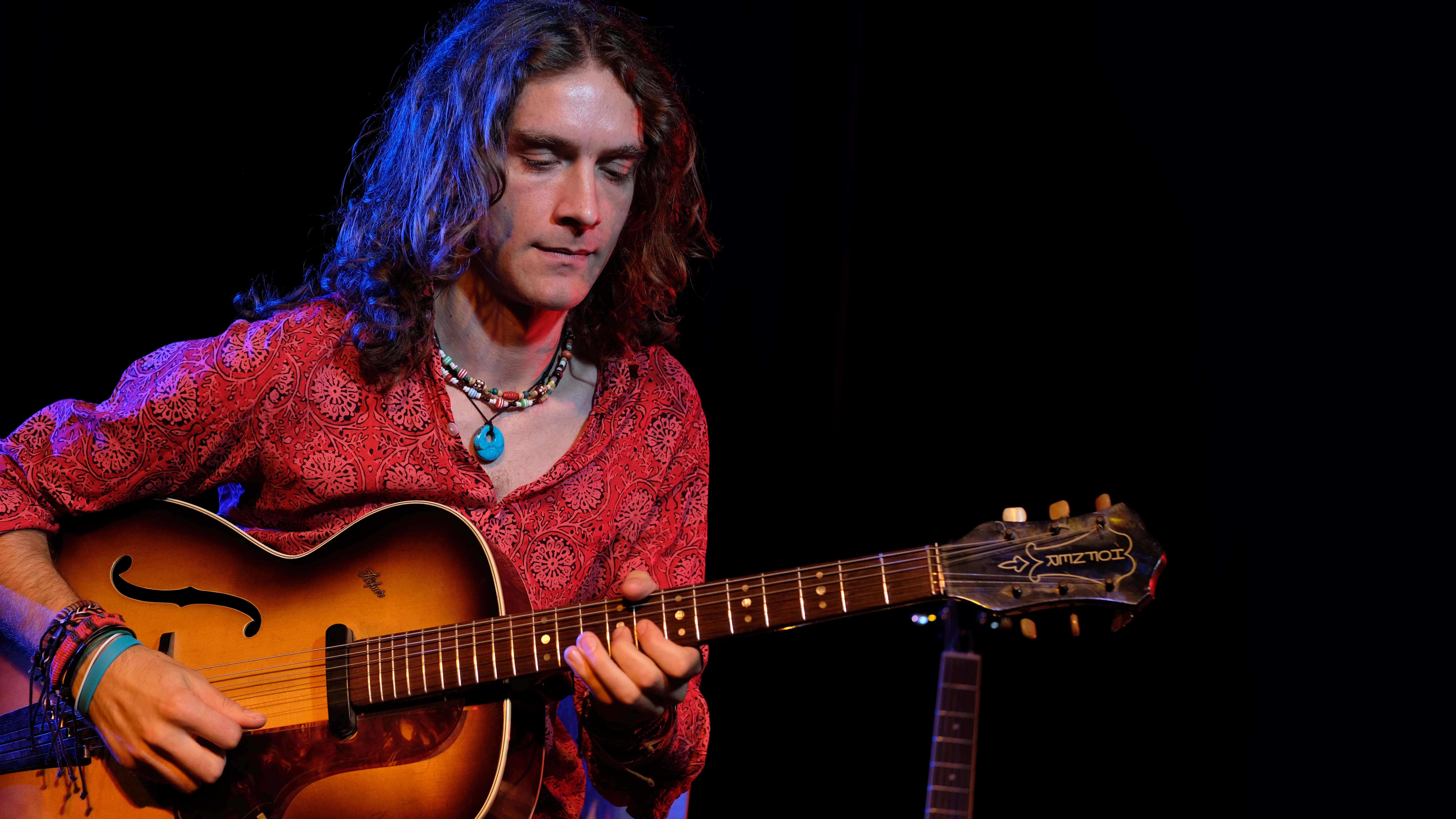
Running out of inspiration as a musician? Guitarist Remi Harris has a quick fix
You're an independent artist; releasing music and booking gigs under the umbrella of Yardbird Arts and it's really inspiring to see that. Can you tell us a bit more about that because it must be a lot of work?
"It is. I do it with my wife, Dani. And we're a team. I cover a certain side of things; the music, and I do a lot of the web stuff as well. And Dani does the gig booking and it's a a big job. But I think in this day and age with the way the internet is. You don't need to wait for the big record contract anymore. You can just get out there. The audience is right there if you can show them what you can do. Hopefully, some people like it. You can tell them where you're playing. You can get them to your gigs. You can release music and hopefully people will like it.
"You can really get things going yourself now. Whereas, in the past, you'd get a band together and hope to get signed. But I don't think that needs to happen."
- Follow Remi Harris for lessons and playing videos on Instagram, YouTube and TikTok. Remi will be playing jazz and blues gigs through 2023; visit remiharris.com for the latest listings.
Support Remi's music directly and buy a CD album from Yardbird Arts
Buy Remi's 100 Gypsy Jazz Licks book at Amazon

Rob is the Reviews Editor for GuitarWorld.com and MusicRadar guitars, so spends most of his waking hours (and beyond) thinking about and trying the latest gear while making sure our reviews team is giving you thorough and honest tests of it. He's worked for guitar mags and sites as a writer and editor for nearly 20 years but still winces at the thought of restringing anything with a Floyd Rose.









